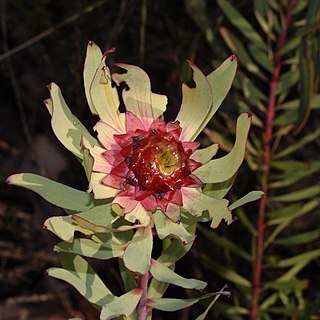Shrubs up to 1.3 m, erect, with few branches, arising from a single ste below. Branches erect, fairly stout, thinly tomentose becoming glabro µpurplish, thickened near the head. Leaves of male plants 6.4 cm long, 2.1 c broad, of female plants 7.5 cm long, 2.4 cm broad, in both sexes increasing in size towards the head, oblanceolate-elliptic, rounded at the apex with th callus immersed, glabrous, subglaucous, not shining, distinctly veine deflexed at the base then spreading, rigidly coriaceous, the upper leave becoming yellow. Involucral leaves similar to the stem leaves, more crowde yellowish, spreading. Male inflorescence 3.5 cm long, 3.5 cm diam., cylindrical, solitary, terminal, with the florets at the top and with the sides imbricate by the reflexed bracts, giving off a sweet fruity smell. Basal bracts 1.7 cm Iong 6.5 mm broad, about 107 in number, oblong, subacute, glabrous, ciliate below recurved and adpressed upon those below, sub-glaucous, not shining, not oil the inner becoming silky-pubescent towards the base. Floral bract 1.7 cm Ion 2 mm broad, linear, the sides long-crisped-ciliate, densely villous in the upper part, apex acute and glabrous. Floral bud 1.8 cm long, slender, acute, glabro µPerianth tube 1.3 cm long, terete, glabrous, surrounded by a few hairs at the base. Claw 4 mm long, recurved 135°, glabrous. Limb 6 mm long, linear, hooked, glabrous. Anther 5 mm long, linear, erect, presenting the pollen. Pollen triangular in polar view with sides 38 µ long, polar depth 25 µ. Stigma abortive, 0.4 mm broad, terminal, cleft. Style 1.6 cm long, filiform, narrower above, sparsely pubescent below, exceeding the tube by 3 mm. Hypogynous scales 4.5 mm long, filiform. Nectar not seen. Receptacle 1.7 cm long, 1.2 cm diam., cylindro-conical. Female inflorescence 3.5 cm long, 3.5 cm diam., cylindrical with the florets at the apex, giving off a sweet pleasant smell. Basal bracts about 89 in number, similar to the male, reddish, the inner becoming broader at the base. Floral bract 1.4 cm long, 0.9 cm broad, broadly lanceolate, obtuse, glabrous above, densely pubescent below, sides ciliate. Foral bud 1.2 cm long, apex glabrous, otherwise densely pubescent. Perianth tube 1.1 cm long, densely pubescent, surrounded below by a tuft of hairs. Claw 2 mm long. Limb 2 mm long, glabrous, concave, hooked. Staminode 1 mm long, linear, erect. Ovary 1.3 mm long, ovoid, glabrous. Style 1.3 cm long, filiform, glabrous. Stigma 0.6 mm broad, terminal, cleft. Hypogynous scales 3.7 mm long, filiform. Nectar not seen. Receptacle 1.7 cm long, 1 cm diam., cylindro-conical. Mature female head dehiscent, 5 cm long, 4.5 cm diam., globose, with bracts sub-quadrangular, acute, densely pubescent below. Fruit a nut, 9-10 mm long, 9-9.5 mm broad, 4-5 mm thick, biconvex, perimeter ridged, glabrous with a few hairs around the basal scar, brown, smooth, not shining.
More
Shrub, erect, few branches, 1.0-1.3 m high, dioecious. Leaves oblanceolate-elliptic, hairless, hanging, apex curving upwards, 64 x 21 mm in male plants, 74 x 24 mm in female ones, glaucous, purplish grey, apex with sunken, fine, point; involucral leaves similar to leaves, denser, spreading, yellow. Male flowers in terminal, cylindrical capitula with flowers on upper surface, sweet smelling, 35 x 35 mm; bracts hairy. Female flowers in terminal, cylindrical capitula, 35 x 35 mm, surrounded by involucral leaves. Involucral bracts ± 89, reddish, recurved, not oily. Mature capitulum 50 x 44 mm, globose; bracts recurved, quadrangular, tip pointed, densely hairy below. Flowering time July, Aug. Fruit with ridged perimeter, released.
Like L. tinctum but leaves shorter, to 64 mm long (male), to 75 mm long (female), bracts not oily.


